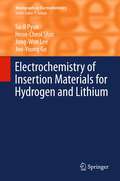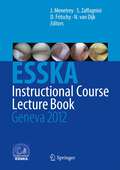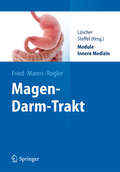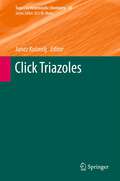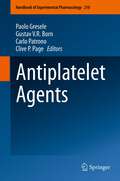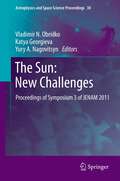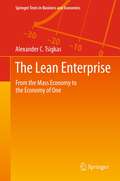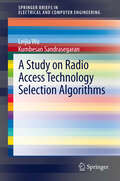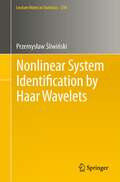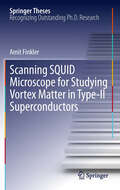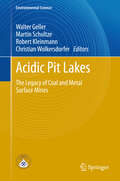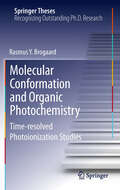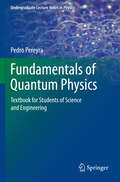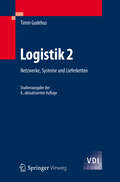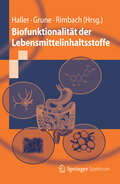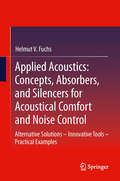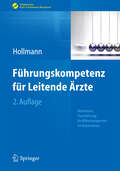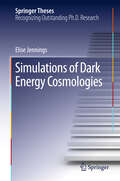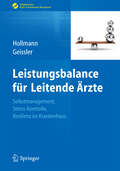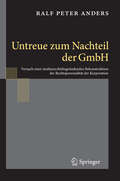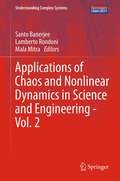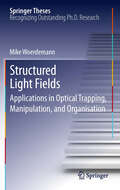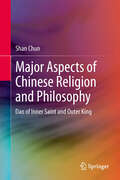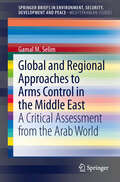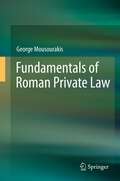- Table View
- List View
Electrochemistry of Insertion Materials for Hydrogen and Lithium
by Joo-Young Go Su-Il Pyun Jong-Won Lee Heon-Cheol ShinThe understanding of hydrogen/lithium insertion phenomena is of great importance for the development of the next generation of functional electrochemical devices such as rechargeable batteries, electrochromic devices, and fuel cells. This volume introduces a variety of viable electrochemical methods to identify reaction mechanisms and evaluate relevant kinetic properties of insertion electrodes. The authors also outline various ways to analyze anomalous behaviour of hydrogen/lithium transport through insertion electrodes.
ESSKA Instructional Course Lecture Book
by Stefano Zaffagnini C. Niek Dijk Daniel Fritschy Jacques MenetreyThis book contains a collection of instructional course lectures given during the 15th ESSKA (European Society of Sports Traumatology, Knee Surgery and Arthroscopy) Congress, held in Geneva during May 2012. The lectures cover a wide range of hot topics in the field, including diverse injuries and management techniques. Each lecture has a practical focus and provides an up-to-date synthesis of core knowledge on the subject in question with the aid of high-quality illustrations. Take home messages and key recommendations are highlighted. This book will be of value to practitioners and researchers alike.
Magen-Darm-Trakt
by Thomas F. Lüscher Jan SteffelSeit 2007 gibt es den Modellstudiengang Medizin an den Hochschulen in Aachen, Berlin, Bochum, Hannover, Heidelberg, Köln, Witten und Göttingen. Die in 17 Themenblöcke gegliederte Lehre folgt der Approbationsordnung für Ärzte, die Prüfungen sind den einzelnen Modulen zugeordnet. Das Lehrbuch Gastroenterologie ist das erste Buch zum Lernen im Modul. Gut verständlich wird das gesamte Organsystem dargestellt: von der Anatomie bis zur Therapie. Das Buch ist geeignet für Medizinstudenten und für Ärzte in der Aus- und Weiterbildung.
Click Triazoles (Topics in Heterocyclic Chemistry #28)
by Janez KošmrljB. R. Buckley and H. Heaney: Mechanistic Investigations of Copper(I)- Catalyzed Alkyne-Azide Cycloaddition Reactions.- J. D. Crowley and D. A. McMorran: "Click-Triazole" Coordination Chemistry: Exploiting 1,4-Disubstituted-1,2,3-Triazoles as Ligands.- S. Lee and A. H. Flood: Binding Anions in Rigid and Reconfigurable Triazole Receptors.- M. Watkinson: Click Triazoles as Chemosensors.- H.-F. Chow, C.-M. Lo and Y. Chen: Triazole-Based Polymer Gels.- T. Zheng, S. H. Rouhanifard, A. S. Jalloh, P. Wu: Click Triazoles for Bioconjugation.- S. Mignani, Y. Zhou, T. Lecourt and L. Micouin: Recent Developments in the Synthesis 1,4,5-Trisubstituted Triazoles.
Antiplatelet Agents (Handbook of Experimental Pharmacology #210)
by Clive P. Page Gustav V. Born Paolo Gresele Carlo PatronoAntiplatelet therapy is the cornerstone of treatment of ischemic cardiovascular disease and over the last few years spectacular advancements in this field have been recorded. This is the first comprehensive handbook entirely dedicated to all the aspects of antiplatelet therapy. The book is divided into three main sections, pathophysiology, pharmacology and therapy, for a total of 23 chapters. A large group of leading experts from different European countries and from the USA, both from academia and industry, have contributed to the book. Besides a detailed overview on the pharmacology and clinical applications of all the currently used or of the novel antiplatelet agents, innovative approaches (e.g. intracellular signalling as an antiplatelet target, small RNAs as platelet therapeutics, etc.) or unconventional aspects (e.g. pharmacologic modulation of the inflammatory action of platelets are also treated. The book is oriented to both basic investigators and to clinicians involved with research on platelet inhibition or with the clinical use of antiplatelet therapies.
The Sun: New Challenges
by Katya Georgieva Vladimir N. Obridko Yury A. NagovitsynThese are the proceedings of the Symposium 3 of JENAM 2011 on new scientific challenges posed by the Sun. The topics covered are 1. The unusual sunspot minimum, which poses challenges to the solar dynamo theory 2. The Sun's Terra-Hertz emission, which opens a new observational window 3. Corona wave activity 4. Space weather agents - initiation, propagation, and forecasting In 21 in-depth contributions, the reader will be presented with the latest findings.
The Lean Enterprise
by Alexander TsigkasThe book is divided into three parts. Part I. The Rising economy of "one" gives an overview of what is changing in the social system of production, it refers to the weakening role of central planning and the rising power of individuation in the value creation chain. Part II. Lean Enterprise in theory refers to the principles of lean thinking, the transfer of lean philosophy from East to West and discusses the necessary adaptation to the Western way of thinking and practice. It presents a practice proven method for achieving a lean integrated demand and supply chain and analyses in detail the related implementation steps. Criteria for a successful displacement of a company to a lean state are presented. Part III. Lean Enterprise in practice provides a number of implementation cases in different types of production companies using the method presented in Part II. The goal is to help the reader comprehend how the method can be applied to real lean implementation situations in resolving various issues, ranging from production to the supply chain. A vision of implementation to lean electricity completes the book.
A Study on Radio Access Technology Selection Algorithms (SpringerBriefs in Electrical and Computer Engineering)
by Leijia Wu Kumbesan SandrasegaranThis book discusses the basic idea of Common Radio Resource Management (CRRM), especially on the Radio Access Technologies selection part of CRRM. It introduces two interaction functions (information reporting function and RRM decision support function) and four interaction degrees (from low to very high) of CRRM. Four possible CRRM topologies (CRRM server, integrated CRRM, Hierarchical CRRM, and CRRM in user terminals) are described. The book presents different Radio Access Technologies selection algorithms, including single criterion and multiple criteria based algorithms are presented and compares them. Finally, the book analyses the advantages and disadvantages of the different selection algorithms.
Nonlinear System Identification by Haar Wavelets
by Przemysław SliwinskiIn order to precisely model real-life systems or man-made devices, both nonlinear and dynamic properties need to be taken into account. The generic, black-box model based on Volterra and Wiener series is capable of representing fairly complicated nonlinear and dynamic interactions, however, the resulting identification algorithms are impractical, mainly due to their computational complexity. One of the alternatives offering fast identification algorithms is the block-oriented approach, in which systems of relatively simple structures are considered. The book provides nonparametric identification algorithms designed for such systems together with the description of their asymptotic and computational properties.
Scanning SQUID Microscope for Studying Vortex Matter in Type-II Superconductors
by Amit FinklerCommon methods of local magnetic imaging display either a high spatial resolution and relatively poor field sensitivity (MFM, Lorentz microscopy), or a relatively high field sensitivity but limited spatial resolution (scanning SQUID microscopy). Since the magnetic field of a nanoparticle or nanostructure decays rapidly with distance from the structure, the achievable spatial resolution is ultimately limited by the probe-sample separation. This thesis presents a novel method for fabricating the smallest superconducting quantum interference device (SQUID) that resides on the apex of a very sharp tip. The nanoSQUID-on-tip displays a characteristic size down to 100 nm and a field sensitivity of 10^-3 Gauss/Hz^(1/2). A scanning SQUID microsope was constructed by gluing the nanoSQUID-on-tip to a quartz tuning-fork. This enabled the nanoSQUID to be scanned within nanometers of the sample surface, providing simultaneous images of sample topography and the magnetic field distribution. This microscope represents a significant improvement over the existing scanning SQUID techniques and is expected to be able to image the spin of a single electron.
Acidic Pit Lakes: The Legacy of Coal and Metal Surface Mines (Environmental Science and Engineering)
by Bob Kleinmann Christian Wolkersdorfer Martin Schultze Walter GellerThis monograph provides an international perspective on pit lakes in post-mining landscapes, including the problem of geogenic acidification. Much has been learned during the last decade through research and practical experience on how to mitigate or remediate the environmental problems of acidic pit lakes. In the first part of the book, general scientific issues are presented in 21 contributions from the fields of geo-environmental science, water chemistry, lake physics, lake modeling, and on the peculiar biological features that occur in the extreme habitats of acidic pit lakes. Another chapter provides an overview of methods currently used to remediate acidic pit lakes and treat outflowing acidic water. The second part of the book is a collection of regional surveys of pit lake problems from three European countries and Australia, and case studies of various individual representative lakes. A final case study provides an innovative approach to assessing the economic value of new pit lakes and balancing the costs and benefits, a valuable tool for decision makers.
Molecular Conformation and Organic Photochemistry
by Rasmus Y. BrogaardRasmus Brogaard's thesis digs into the fundamental issue of how the shape of a molecule relates to its photochemical reactivity. This relation is drastically different from that of ground-state chemistry, since lifetimes of excited states are often comparable to or even shorter than the time scales of conformational changes. Combining theoretical and experimental efforts in femto-second time-resolved photoionization Rasmus Brogaard finds that a requirement for an efficient photochemical reaction is the prearrangement of the constituents in a reactive conformation. Furthermore, he is able to show that by exploiting a strong ionic interaction between two chromophores, a coherent molecular motion can be induced and probed in real-time. This way of using bichromophoric interactions provides a promising strategy for future research on conformational dynamics.
Fundamentals of Quantum Physics
by Pedro PereyraThis book presents a comprehensive course of quantum mechanics for undergraduate and graduate students. After a brief outline of the innovative ideas that lead up to the quantum theory, the book reviews properties of the Schrödinger equation, the quantization phenomena and the physical meaning of wave functions. The book discusses, in a direct and intelligible style, topics of the standard quantum formalism like the dynamical operators and their expected values, the Heisenberg and matrix representation, the approximate methods, the Dirac notation, harmonic oscillator, angular momentum and hydrogen atom, the spin-field and spin-orbit interactions, identical particles and Bose-Einstein condensation etc. Special emphasis is devoted to study the tunneling phenomena, transmission coefficients, phase coherence, energy levels splitting and related phenomena, of interest for quantum devices and heterostructures. The discussion of these problems and the WKB approximation is done using the transfer matrix method, introduced at a tutorial level. This book is a textbook for upper undergraduate physics and electronic engineering students.
Logistik
by Timm GudehusZentrale Aufgabe der operativen Logistik ist das effiziente Bereitstellen benötigter Mengen zur rechten Zeit am richtigen Ort. Das Standardwerk behandelt die Grundlagen und das Handwerkszeug zur kreativen Bearbeitung der vielfältigen Logistikaufgaben, der innerbetrieblichen (Intralogistik) wie außerbetrieblichen Logistiknetzwerke. Es bietet praxiserprobte Strategien und Optimierungsverfahren sowie Regeln, Algorithmen und Formeln für die rechnergestützte Planung von Logistiksystemen und für die dynamische Disposition in Versorgungsnetzen.
Biofunktionalität der Lebensmittelinhaltsstoffe (Springer-Lehrbuch)
by Gerald Rimbach Tilman Grune Dirk HallerFunktionelle Lebensmittel wirken nachweisbar stärker positiv auf die menschliche Gesundheit als normale. Das erste Lehrbuch zum Thema behandelt systematisch die Organfunktionen des Körpers und zeigt die Methoden, mit denen eine präventive Wirkung nachgewiesen werden kann. "Steckbriefe" aller relevanten Klassen von Lebensmittelinhaltsstoffen und deren Wirksamkeit bieten einen guten Überblick. Ergänzt wird das mit Abbildungen und Themenboxen anschaulich gestaltete Nachschlagewerk für Studenten und Lebensmittelexperten durch zahlreiche Fallbeispiele.
Applied Acoustics: Alternative Solutions - Innovative Tools - Practical Examples
by Helmut V. FuchsThe author gives a comprehensive overview of materials and components for noise control and acoustical comfort. Sound absorbers must meet acoustical and architectural requirements, which fibrous or porous material alone can meet. Basics and applications are demonstrated, with representative examples for spatial acoustics, free-field test facilities and canal linings. Acoustic engineers and construction professionals will find some new basic concepts and tools for developments in order to improve acoustical comfort. Interference absorbers, active resonators and micro-perforated absorbers of different materials and designs complete the list of applications.
Führungskompetenz für Leitende Ärzte
by Jens HollmannLeitende Ärzte müssen neben dem fachlichen Know-How immer häufiger Führungskompetenzen zeigen, Mitarbeiter motivieren und Impulse setzen. Dieses Buch gibt mit wissenschaftlichen Erkenntnissen aus Betriebswirtschaft und Psychologie Lösungsstrategien und Praxisempfehlungen an die Hand. Gut umsetzbar werden diese durch Checklisten, Kopiervorlagen für Mitarbeitergespräche, Tests für Situationstransparenz sowie den Abgleich von Selbst- und Fremdbild. Kurz-Interviews mit Führungskräften aus dem Kliniksektor und den Verbänden zeigen Lösungsstrategien auf.
Simulations of Dark Energy Cosmologies
by Elise JenningsA major outstanding problem in physics is understanding the nature of the dark energy that is driving the accelerating expansion of the Universe. This thesis makes a significant contribution by demonstrating, for the first time, using state-of-the-art computer simulations, that the interpretation of future galaxy survey measurements is far more subtle than is widely assumed, and that a major revision to our models of these effects is urgently needed. The work contained in the thesis was used by the WiggleZ dark energy survey to measure the growth rate of cosmic structure in 2011 and had a direct impact on the design of the surveys to be conducted by the European Space Agency's Euclid mission, a 650 million euro project to measure dark energy.
Leistungsbalance für Leitende Ärzte
by Angela Geissler Jens HollmannPerspektiven für Gestalter! Wenn wir davon ausgehen müssen, dass die wachsenden Anforderungen an Leitende Ärzte und die Arbeitsverdichtung erst den Beginn eines Zyklus markieren und keineswegs sein Ende, wird deutlich, dass es Werkzeuge und Techniken braucht, um die verantwortungsvolle Position auch in Zukunft erfolgreich gestalten zu können. Drei Aspekte sind besonders relevant. Standortbestimmung Klinik - Stressoren am Arbeitsplatz - Die Stanford-Formel Standortbestimmung Arzt - Der Präsentismus-Faktor - Die Gratifikationskrise - Typologien des Erfolgs Ressourcen zur Leistungsbalance - Zeit- und Selbstmanagement - Mentale Strategien für Stress-Resistenz - Denk- und Handlungsmuster erkennen und positiv transformieren - Techniken für eine wirksame Selbstregulation MIT - Checklisten - Selbst-Tests - Interviews: Chefärzte eröffnen Perspektiven für die Leistungsbalance "Dieses Buch hilft mit einem innovativen Ansatz ärztlichen Führungskräften, sich neue Perspektiven zu erschließen!" Dr. med. Jörg Ansorg, Hauptgeschäftsführer des Berufsverbandes Deutscher Chirurgen
Untreue zum Nachteil der GmbH: Versuch einer strafunrechtsbegründenden Rekonstruktion der Rechtspersonalität der Korporation
by Ralf Peter AndersDie Arbeit untersucht Grund und Grenzen der Dispositionsbefugnis der Gesellschafter über das GmbH-Vermögen im Rahmen der sog. Organuntreue. Der normative Zusammenhang zwischen der juristischen Person und ihren natürlichen "Hinterleuten" wird in einem neuartigen und grundlegenden Zugang in seinem spezifisch gesellschaftsrechtlichen Kontext in Beziehung zu rechtsphilosophischen Begründungszusammenhängen gesetzt, indem in Abgrenzung zu insbesondere systemtheoretischen und ökonomischen Ansätzen die Grundbegriffe Person, Institution und Korporation unabhängig von kontingenten funktionalistischen und wirtschaftlich-utilitaristischen Erwägungen über ein freiheitlich-intersubjektives Anerkennungsverhältnis bestimmt werden. Die Grenze einer Dispositionsbefugnis der GmbH-Gesellschafter wird dabei über eine unternehmensbezogene teilhabegerechtigkeitstheoretische Aktualisierung der Kantischen Privatrechtslehre entwickelt.
Applications of Chaos and Nonlinear Dynamics in Science and Engineering - Vol. 2 (Understanding Complex Systems)
by Lamberto Rondoni Santo Banerjee Mala MitraChaos and nonlinear dynamics initially developed as a new emergent field with its foundation in physics and applied mathematics. The highly generic, interdisciplinary quality of the insights gained in the last few decades has spawned myriad applications in almost all branches of science and technology--and even well beyond. Wherever the quantitative modeling and analysis of complex, nonlinear phenomena are required, chaos theory and its methods can play a key role. This second volume concentrates on reviewing further relevant, contemporary applications of chaotic nonlinear systems as they apply to the various cutting-edge branches of engineering. This encompasses, but is not limited to, topics such as the spread of epidemics; electronic circuits; chaos control in mechanical devices; secure communication; and digital watermarking. Featuring contributions from active and leading research groups, this collection is ideal both as a reference work and as a 'recipe book' full of tried and tested, successful engineering applications.
Structured Light Fields
by Mike WördemannThe optical trapping of colloidal matter is an unequalled field of technology for enabling precise handling of particles on microscopic scales, solely by the force of light. Although the basic concept of optical tweezers, which are based on a single laser beam, has matured and found a vast number of exciting applications, in particular in the life sciences, there are strong demands for more sophisticated approaches. This thesis gives an introductory overview of existing optical micromanipulation techniques and reviews the state-of-the-art of the emerging field of structured light fields and their applications in optical trapping, micromanipulation, and organisation. The author presents established, and introduces novel concepts for the holographic and non-holographic shaping of a light field. A special emphasis of the work is the demonstration of advanced applications of the thus created structured light fields in optical micromanipulation, utilising various geometries and unconventional light propagation properties. While most of the concepts developed are demonstrated with artificial microscopic reference particles, the work concludes with a comprehensive demonstration of optical control and alignment of bacterial cells, and hierarchical supramolecular organisation utilising dedicated nanocontainer particles.
Major Aspects of Chinese Religion and Philosophy
by Chun ShanThe book addresses academically the major aspects of Chinese religion and philosophy, designated as the doctrine of being internal sage and external king. The perspective applied is the integration between western and Chinese scholarship and English readers may gain an easy and interesting access to Chinese intellectual tradition, distinctive itself in a harmony between being holy and secular in any mundane human being to the western tradition of "Give to Caesar what is Caesar's, and to God what is God's". By this contrast the intellectual charms and spiritual merits of Chinese tradition will be better appreciated, hence conducive to the much anticipated dialogues between western and eastern civilizations at this globalized yet conflicted world.
Global and Regional Approaches to Arms Control in the Middle East: A Critical Assessment from the Arab World
by Gamal M. SelimSince the end of the Cold War, the Middle East has been the focus of various projects for the establishment of arms control (including CBMs) regimes. Whereas some of these projects were initiated at the global level, others were discussed and debated at the regional level. This book analyses the global and regional dynamics of arms control in the Middle East in the post-Cold War era. It examines American and European arms control projects, the contexts in which they were presented, the reactions of major regional actors, and their impacts on arms control efforts in the region. It assesses Arab perceptions of the motivations for and constraints on establishing arms control regimes. It also explores the prospects of regional arms control in the context of the ongoing Arab Spring with its ramifications for Arab regional politics, and provides a new perspective on arms control in the Middle East. This volume enriches the ongoing discourse, which to date has been dominated by mainly Western perspectives.
Fundamentals of Roman Private Law
by George MousourakisRoman law forms a vital part of the intellectual background of many legal systems currently in force in Continental Europe, Latin America, East Asia and other parts of the world. Knowledge of Roman law, therefore, constitutes an essential component of a sound legal education as well as the education of the student of history. This book begins with a historical introduction, which traces the evolution of Roman law from the earliest period of Roman history up to and including Justinian's codification in the sixth century AD. Then follows an exposition of the principal institutions of Roman private law: the body of rules and principles relating to individuals in Roman society and regulating their personal and proprietary relationships. In this part of the book special attention is given to the Roman law of things, which forged the foundations for much of the modern law of property and obligations in European legal systems. Combining a law specialist's informed perspective with a historical and cultural focus, the book provides an accessible source of reference for students and researchers in many diverse fields of legal and historical learning.
